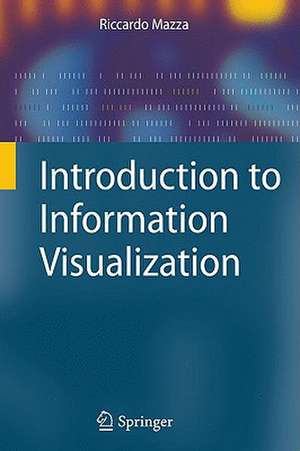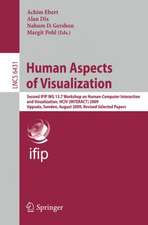Introduction to Information Visualization
Autor Riccardo Mazzaen Limba Engleză Paperback – 2 apr 2009
This book introduces the concepts and methods of Information Visualization in an easy-to-understand way, illustrating how to pictorially represent structured and unstructured data, making it easier to comprehend and interpret. Riccardo Mazza focuses on the human aspects of the process of visualization rather than the algorithmic or graphic design aspects.
Preț: 384.03 lei
Preț vechi: 480.03 lei
-20% Nou
Puncte Express: 576
Preț estimativ în valută:
73.51€ • 79.87$ • 61.79£
73.51€ • 79.87$ • 61.79£
Carte tipărită la comandă
Livrare economică 21 aprilie-05 mai
Preluare comenzi: 021 569.72.76
Specificații
ISBN-13: 9781848002180
ISBN-10: 1848002181
Pagini: 136
Ilustrații: XVIII, 139 p. 93 illus., 81 illus. in color.
Dimensiuni: 155 x 235 x 8 mm
Greutate: 0.27 kg
Ediția:2009
Editura: SPRINGER LONDON
Colecția Springer
Locul publicării:London, United Kingdom
ISBN-10: 1848002181
Pagini: 136
Ilustrații: XVIII, 139 p. 93 illus., 81 illus. in color.
Dimensiuni: 155 x 235 x 8 mm
Greutate: 0.27 kg
Ediția:2009
Editura: SPRINGER LONDON
Colecția Springer
Locul publicării:London, United Kingdom
Public țintă
Professional/practitionerCuprins
to Visual Representations.- Creating Visual Representations.- Perception.- Multivariate Analysis.- Networks and Hierarchies.- WorldWideWeb.- Interactions.- Evaluations.
Recenzii
From the reviews:
"This excellent book is written in an accessible language and is well structured, making it a fine textbook for an introductory course on information visualization (IV). Extensive use of good examples and figures will help readers quickly grasp the essentials of the different techniques and concepts presented. … All in all, this book is a good starting point for understanding the goal of IV, getting a broad overview of the field, comprehending the main techniques proposed to date, and raising interest in future developments." (Angelica de Antonio, ACM Computing Reviews, July, 2009)
“In eight well-illustrated chapters, Mazza moves you through basic theory and simplified visualization techniques to reader response theory and highly complex techniques. … meant to be a textbook for a course in information visualization. … I find this book highly useful in understanding how to handle massive quantities of data visually. … If used as a reference book, it points the way to solving problems related to visual representation of data in real time. … a useful book for both academics and practitioners.” (Tom Warren, Technical Communication, Vol. 57 (3), August, 2010)
"This excellent book is written in an accessible language and is well structured, making it a fine textbook for an introductory course on information visualization (IV). Extensive use of good examples and figures will help readers quickly grasp the essentials of the different techniques and concepts presented. … All in all, this book is a good starting point for understanding the goal of IV, getting a broad overview of the field, comprehending the main techniques proposed to date, and raising interest in future developments." (Angelica de Antonio, ACM Computing Reviews, July, 2009)
“In eight well-illustrated chapters, Mazza moves you through basic theory and simplified visualization techniques to reader response theory and highly complex techniques. … meant to be a textbook for a course in information visualization. … I find this book highly useful in understanding how to handle massive quantities of data visually. … If used as a reference book, it points the way to solving problems related to visual representation of data in real time. … a useful book for both academics and practitioners.” (Tom Warren, Technical Communication, Vol. 57 (3), August, 2010)
Textul de pe ultima copertă
Information Visualization is a relatively young field that is acquiring more and more consensus in both academic and industrial environments. This concise introduction to the subject explores the use of computer-supported interactive graphical representations to explain data and amplify cognition. Written in a lively, yet rigorous, style the book explores ways of communicating ideas or facts about data, and shows how to validate hypotheses, and facilitate the discovery of new facts via exploration.
The concepts outlined in the book are illustrated in a simple and thorough manner, building a reference for those situations in which graphic representation of information, generated and assisted by the use of computer tools, can help in visualizing ideas, data and concepts.
With suggestions for setting communications systems based on, or availing of, graphic representations, this textbook illustrates cases, situations, tools and methods which help make the graphic representations of information effective and efficient.
The concepts outlined in the book are illustrated in a simple and thorough manner, building a reference for those situations in which graphic representation of information, generated and assisted by the use of computer tools, can help in visualizing ideas, data and concepts.
With suggestions for setting communications systems based on, or availing of, graphic representations, this textbook illustrates cases, situations, tools and methods which help make the graphic representations of information effective and efficient.
Caracteristici
Accessible and easy to read Covers techniques specific for the Web and (unlike existing books) techniques for evaluating visualisations Focuses on the human aspects of the process of visualization rather than the algoritmic or graphic design aspects






















